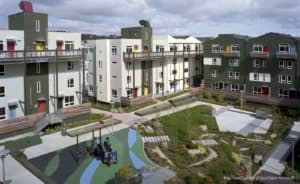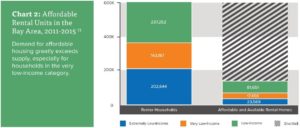
**Update: San Francisco Propositions A and E both passed by the needed margins to fund and zone for affordable homes for educators and vulnerable populations **
When you think of Save The Bay, you may not think of affordable housing, but housing the community is a huge part of our regional planning, and that planning has major ramifications for the health of our Bay. Demand for housing in the Bay greatly exceeds supply, and workers seek more affordable homes farther away from job centers, suffering longer commutes and losing access to public transit. Traffic congestion and crowded, long rides are stressful, and take time away that could be spent with community and family. More cars on the road for longer commutes increase stormwater pollution, delivering oil, micro-plastics from tires and dust from brake pads into the Bay.
Far worse, too many community members are pushed out entirely, losing their shelter. Unsheltered residents have little access to resources, are forced to create temporary homes where and when they are able to find them, and live without services including waste collection, restrooms, and other basic needs. Displacement tears these people from their communities, and lack of access to essential services increases the flow of trash, bacteria, and other toxic pollutants into the Bay.

Save the Bay is doing its part by supporting Bay Smart strategies that promote the interrelated housing policies of “Production, Preservation and Protection”. Saving and creating more affordable housing protects our Bay by decreasing commuter time, traffic and pollutant runoff. Housing security provides residents the time and energy to invest in this community, enhancing collective stewardship of the Bay as the commons of the Bay Area. Preventing displacement and providing unhoused residents the shelter they need creates a healthier community and a healthier Bay.
Our latest effort to support affordable housing is in San Francisco. Save The Bay was proud to endorse Proposition A and Proposition E on the San Francisco ballot in November 2019.
San Francisco has talked about building educator housing for years, but has struggled to come up with a strategy and funds to keep educators in the communities they serve. The biggest barriers affordable housing developers have faced in San Francisco include limited land and limited city funding. At the same time, there are many large, underused lots across the city where affordable housing could be built, but where housing development is not currently permitted.
One solution, proposed by affordable housing advocates and a large and diverse coalition of unions, non-profit organizations, and local and state legislators, was a set of two ballot measures to address both funding and land use changes to permit affordable development:
- Proposition A: Championed by both Mayor London Breed and the entire San Francisco Board of Supervisors, Prop. A allows the city to sell $600 million worth of bonds to build, rehabilitate or acquire affordable housing in San Francisco. The measure will lead to the construction of about 2,800 new affordable housing units in the next four years.
- Proposition E: Will allow for 100% affordable and educator housing to be built on parcels of public land, where such projects are currently prohibited. As the city grapples with the twin crises of homelessness and ultra-high housing costs, the measure is meant to open up more of the city to affordable housing development. The measure was signed onto the ballot by four supervisors — Sandra Lee Fewer, Matt Haney, Shamann Walton and Aaron Peskin — and was also supported by Mayor Breed.
These complementary ballot measures appeared on San Francisco’s November 2019 ballot and we were excited to celebrate the passage of both. Supporting the protection, production and preservation of affordable homes is a great way to support our Bay ecology and our Bay community, and we look forward to future opportunities to support critical measures like these, in San Francisco and across all nine Bay Area counties.

















































